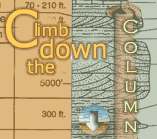

When stratigraphers closely study the rock layers, the stratigraphic column is very detailed.
Take a look at the Dinosaur National Monument stratigraphic column above. Each rock layer shows the rock type, such as sandstone, limestone, or shale. It includes the types of fossils that have been found within the layer.
The column also includes useful information about which formation created prominent park features such as Steamboat Rock, and which rock units are most likely to produce landslides.
Stratigraphy is the branch of geology that deals with the layers of rock that make up the earth's crust. A stratigrapher studies how layers of rocks were formed; how the layers changed over time; and how the layers relate to layers of rock at other places around the world.
Stratigraphers develop stratigraphic columns to show rocks at the surface of a particular spot, and all the rock layers that lie below the surface.
The layers in a stratigraphic column are usually stacked from oldest [bottom] to youngest [top]. They carry the official name of the rock, as well as the age or time period when the layer was deposited.


